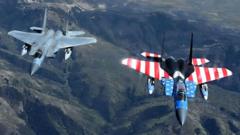More than 3,000 defence workers at Boeing are preparing to strike on Monday, delivering yet another setback to the already troubled aviation giant. Employees from Missouri and Illinois, responsible for the production of F-15 fighter jets and other military aircraft, recently voted against Boeing's latest offer due to disputes over wages, work schedules, and pensions. Dan Gillian, vice president of Boeing's Air Dominance unit, expressed disappointment over the rejection, noting that the proposal included a significant average wage increase of 40%.
This impending strike represents a crucial moment for Boeing, which has already faced numerous challenges, including safety concerns and a disruptive seven-week strike by its passenger airplane workforce last year. The action is spearheaded by a local chapter of the International Association of Machinists and Aerospace Workers (IAM) based in St Louis, the heart of Boeing’s defence manufacturing operations.
Union leadership, including Tom Boelling, has vocally asserted that members are determined to secure a contract commensurate with their skills and the important role they play in the nation's defense efforts. IAM, one of the largest unions in the U.S., represents around 600,000 individuals across various sectors, including aerospace and manufacturing.
Boeing has endured a series of crises over the past few years, including two catastrophic deadly crashes linked to the 737 Max and other operational malfunctions. In 2018, the crash of a Boeing 737 in Indonesia claimed all 189 lives aboard, followed by another disaster in Ethiopia months later that resulted in 157 fatalities. The company also faced significant operational challenges, reporting a mere 348 aircraft deliveries last year — its lowest production rate since the pandemic.
Past strikes, including a major work stoppage of approximately 30,000 passenger jet workers last year, resulted in severe financial repercussions for Boeing. With growing uncertainties, industry experts question whether Boeing can successfully navigate the turbulence and restore its standing in the aviation landscape.




















